Management Accounting Report: A Comparison of Costing Systems
VerifiedAdded on 2021/06/18
|15
|2683
|127
Report
AI Summary
This report analyzes the application of traditional and activity-based costing (ABC) methods within the context of Happy Traveller Ltd., a manufacturing company producing simple and complex luggage. The report's purpose is to compare the two costing approaches, highlighting their significance and calculating the cost per unit for each product under both systems. The traditional costing approach uses a single overhead rate, while ABC assigns costs based on multiple cost drivers. The report details the allocation of manufacturing overhead costs, including indirect wages, materials, and facility expenses, across various production and service centers. It then compares the resulting cost per unit for simple and complex luggage under both systems, showing how the ABC method provides a more detailed and potentially more accurate cost allocation. The analysis also considers the costs and benefits of adopting ABC, concluding with an overview of other relevant factors influencing the choice of costing method.
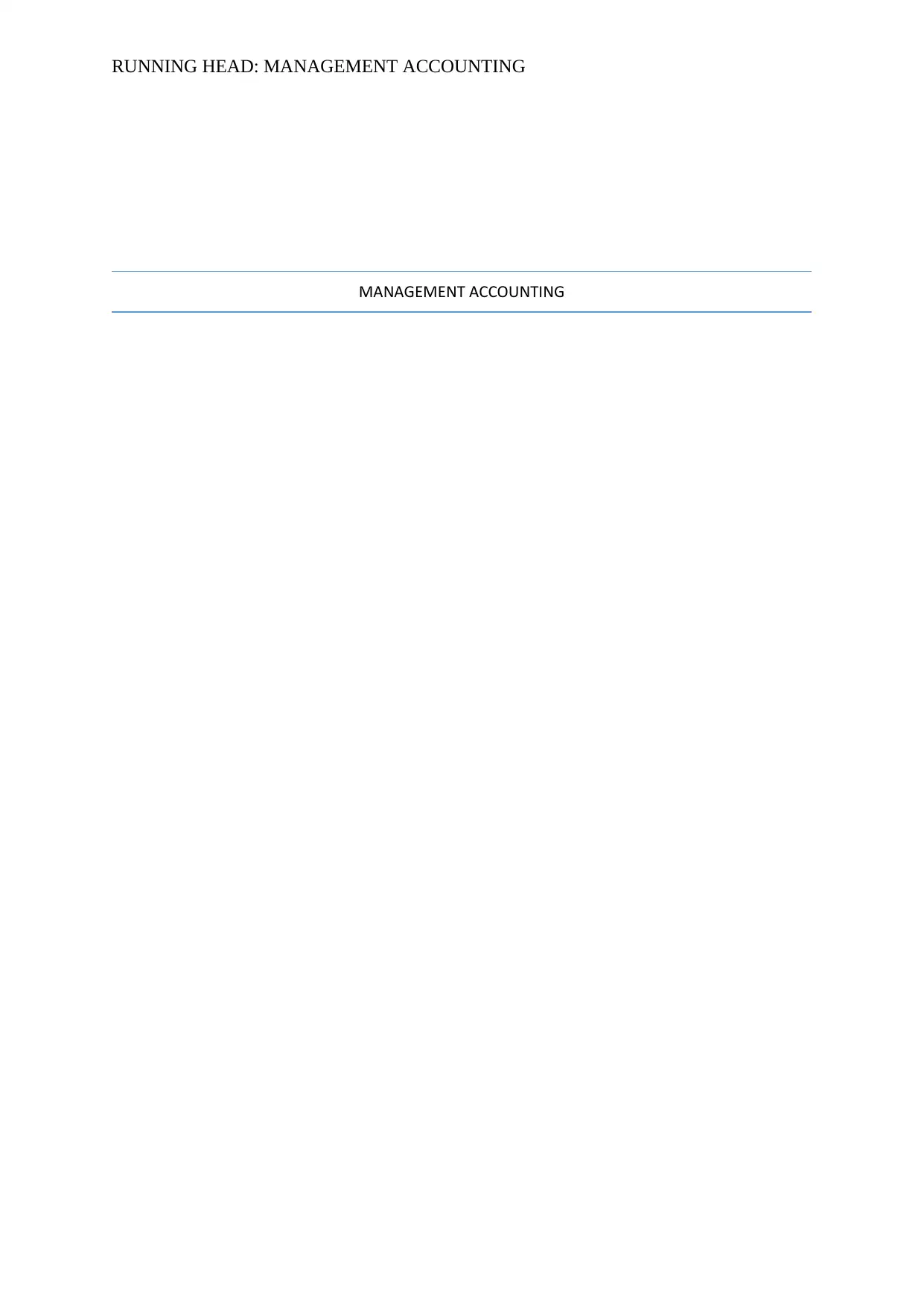
RUNNING HEAD: MANAGEMENT ACCOUNTING
MANAGEMENT ACCOUNTING
MANAGEMENT ACCOUNTING
Paraphrase This Document
Need a fresh take? Get an instant paraphrase of this document with our AI Paraphraser

MANAGEMENT ACCOUNTING 1
Contents
INTRODUCTION.....................................................................................................................................2
Purpose.............................................................................................................................................2
Significance of two costing methods.................................................................................................2
DISCUSSION...........................................................................................................................................2
Traditional costing approach.............................................................................................................2
Activity based costing approach........................................................................................................6
COMPARISON AND DIFFERENCES OF PRODUCT COSTS CALCULATED UNDER TRADITIONAL AND
ABC SYSTEM....................................................................................................................................11
CONCLUSION.......................................................................................................................................12
COST VERSUS BENEFITS OF ABC SYSTEM.........................................................................................12
OTHER FACTORS OF ABC SYSTEM....................................................................................................13
REFERENCES........................................................................................................................................14
Contents
INTRODUCTION.....................................................................................................................................2
Purpose.............................................................................................................................................2
Significance of two costing methods.................................................................................................2
DISCUSSION...........................................................................................................................................2
Traditional costing approach.............................................................................................................2
Activity based costing approach........................................................................................................6
COMPARISON AND DIFFERENCES OF PRODUCT COSTS CALCULATED UNDER TRADITIONAL AND
ABC SYSTEM....................................................................................................................................11
CONCLUSION.......................................................................................................................................12
COST VERSUS BENEFITS OF ABC SYSTEM.........................................................................................12
OTHER FACTORS OF ABC SYSTEM....................................................................................................13
REFERENCES........................................................................................................................................14
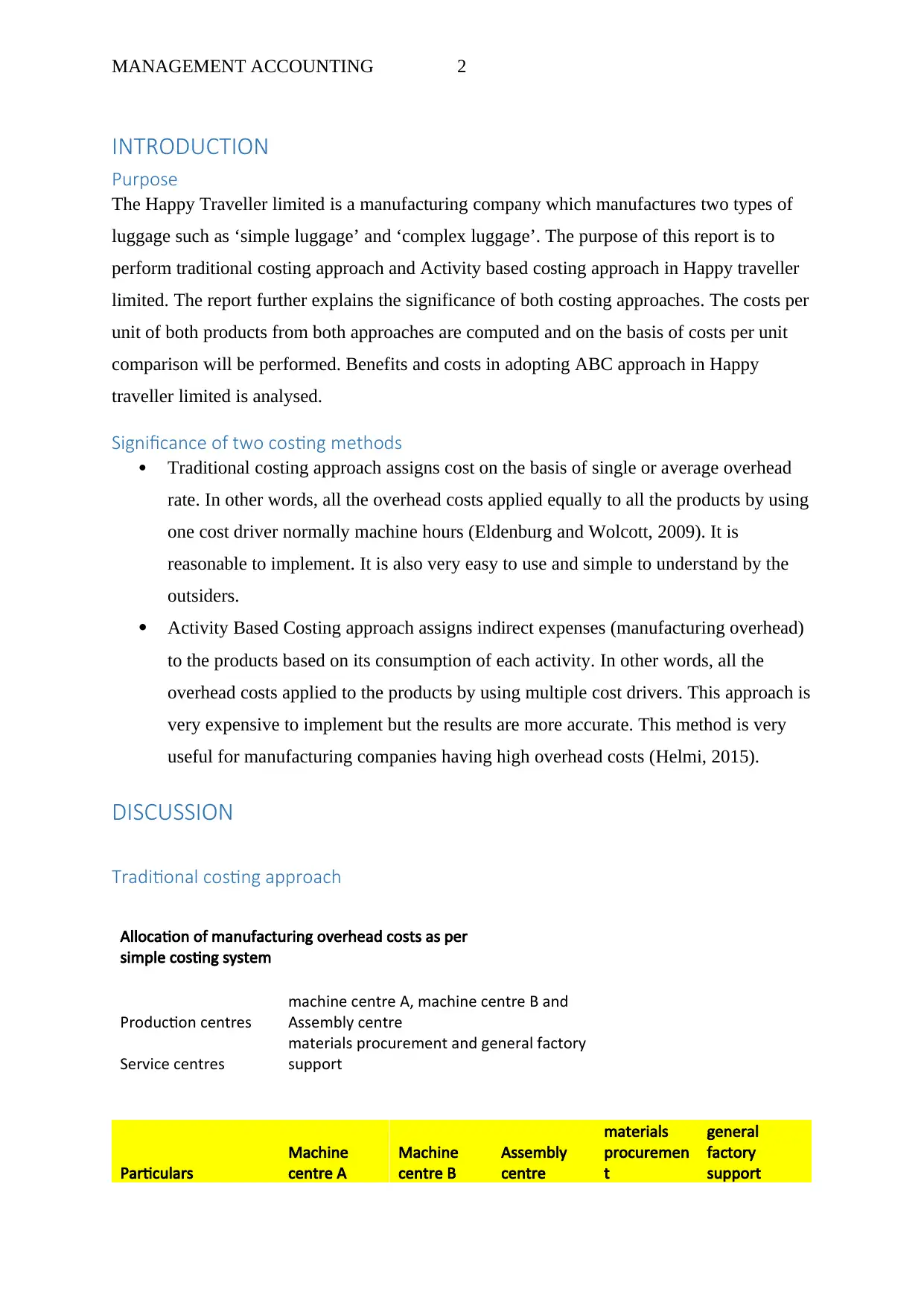
MANAGEMENT ACCOUNTING 2
INTRODUCTION
Purpose
The Happy Traveller limited is a manufacturing company which manufactures two types of
luggage such as ‘simple luggage’ and ‘complex luggage’. The purpose of this report is to
perform traditional costing approach and Activity based costing approach in Happy traveller
limited. The report further explains the significance of both costing approaches. The costs per
unit of both products from both approaches are computed and on the basis of costs per unit
comparison will be performed. Benefits and costs in adopting ABC approach in Happy
traveller limited is analysed.
Significance of two costing methods
Traditional costing approach assigns cost on the basis of single or average overhead
rate. In other words, all the overhead costs applied equally to all the products by using
one cost driver normally machine hours (Eldenburg and Wolcott, 2009). It is
reasonable to implement. It is also very easy to use and simple to understand by the
outsiders.
Activity Based Costing approach assigns indirect expenses (manufacturing overhead)
to the products based on its consumption of each activity. In other words, all the
overhead costs applied to the products by using multiple cost drivers. This approach is
very expensive to implement but the results are more accurate. This method is very
useful for manufacturing companies having high overhead costs (Helmi, 2015).
DISCUSSION
Traditional costing approach
Allocation of manufacturing overhead costs as per
simple costing system
Production centres
machine centre A, machine centre B and
Assembly centre
Service centres
materials procurement and general factory
support
Particulars
Machine
centre A
Machine
centre B
Assembly
centre
materials
procuremen
t
general
factory
support
INTRODUCTION
Purpose
The Happy Traveller limited is a manufacturing company which manufactures two types of
luggage such as ‘simple luggage’ and ‘complex luggage’. The purpose of this report is to
perform traditional costing approach and Activity based costing approach in Happy traveller
limited. The report further explains the significance of both costing approaches. The costs per
unit of both products from both approaches are computed and on the basis of costs per unit
comparison will be performed. Benefits and costs in adopting ABC approach in Happy
traveller limited is analysed.
Significance of two costing methods
Traditional costing approach assigns cost on the basis of single or average overhead
rate. In other words, all the overhead costs applied equally to all the products by using
one cost driver normally machine hours (Eldenburg and Wolcott, 2009). It is
reasonable to implement. It is also very easy to use and simple to understand by the
outsiders.
Activity Based Costing approach assigns indirect expenses (manufacturing overhead)
to the products based on its consumption of each activity. In other words, all the
overhead costs applied to the products by using multiple cost drivers. This approach is
very expensive to implement but the results are more accurate. This method is very
useful for manufacturing companies having high overhead costs (Helmi, 2015).
DISCUSSION
Traditional costing approach
Allocation of manufacturing overhead costs as per
simple costing system
Production centres
machine centre A, machine centre B and
Assembly centre
Service centres
materials procurement and general factory
support
Particulars
Machine
centre A
Machine
centre B
Assembly
centre
materials
procuremen
t
general
factory
support
⊘ This is a preview!⊘
Do you want full access?
Subscribe today to unlock all pages.

Trusted by 1+ million students worldwide

MANAGEMENT ACCOUNTING 3
Indirect wages and
supervision
$
14,61,538.46
$
8,76,923.08
$
14,61,538.4
6
$
21,00,000.0
0
$
18,80,000.00
Total costs = $
3800000
total hours =
5200000
Indirect materials
$
6,50,000.00
$
4,87,500.00
$
1,62,500.00
$
-
$
20,000.00
Total costs = $
1300000
material issued = $
4000000, $ 3000000
and $ 1000000 for
Machine centre A, B
and assembly centre
respectively
Lighting and heating
$
95,192.31
$
84,615.38
$
1,26,923.08
$
1,58,653.85
$
84,615.38
Total costs = $
550000
Area occupied =
52000 square metre
property taxes
$
1,47,115.38
$
1,30,769.23
$
1,96,153.85
$
2,45,192.31
$
1,30,769.23
Total costs = $
850000
Area occupied =
52000 square metre
insurance of
machinery
$
1,31,578.95
$
90,460.53
$
13,157.89
$
6,578.95
$
8,223.68
Total costs = $
250000
BV of machinery = $
15200000
Depreciation of
machinery
$
8,42,105.26
$
5,78,947.37
$
84,210.53
$
42,105.26
$
52,631.58
Total costs = $
1600000
BV of machinery = $
15200000
Insurance of
buildings
$
51,923.08
$
46,153.85
$
69,230.77
$
86,538.46
$
46,153.85
Total costs = $
Indirect wages and
supervision
$
14,61,538.46
$
8,76,923.08
$
14,61,538.4
6
$
21,00,000.0
0
$
18,80,000.00
Total costs = $
3800000
total hours =
5200000
Indirect materials
$
6,50,000.00
$
4,87,500.00
$
1,62,500.00
$
-
$
20,000.00
Total costs = $
1300000
material issued = $
4000000, $ 3000000
and $ 1000000 for
Machine centre A, B
and assembly centre
respectively
Lighting and heating
$
95,192.31
$
84,615.38
$
1,26,923.08
$
1,58,653.85
$
84,615.38
Total costs = $
550000
Area occupied =
52000 square metre
property taxes
$
1,47,115.38
$
1,30,769.23
$
1,96,153.85
$
2,45,192.31
$
1,30,769.23
Total costs = $
850000
Area occupied =
52000 square metre
insurance of
machinery
$
1,31,578.95
$
90,460.53
$
13,157.89
$
6,578.95
$
8,223.68
Total costs = $
250000
BV of machinery = $
15200000
Depreciation of
machinery
$
8,42,105.26
$
5,78,947.37
$
84,210.53
$
42,105.26
$
52,631.58
Total costs = $
1600000
BV of machinery = $
15200000
Insurance of
buildings
$
51,923.08
$
46,153.85
$
69,230.77
$
86,538.46
$
46,153.85
Total costs = $
Paraphrase This Document
Need a fresh take? Get an instant paraphrase of this document with our AI Paraphraser

MANAGEMENT ACCOUNTING 4
300000
Area occupied =
52000 square metre
Salaries of works
management
$
3,40,000.00
$
2,10,000.00
$
3,50,000.00
$
1,00,000.00
$
1,00,000.00
Total costs = $
1100000
Number of
employees = 1100
employees
TOTAL
MANUFACTURING
OVERHEAD COSTS
$
37,19,453.44
$
25,05,369.4
3
$
24,63,714.5
7
$
27,39,068.8
3
$
23,22,393.72
Further costs of two service centres (materials procurement and general factory support) will
further allocated to three production centre costs (machine centre A, machine centre B and
Assembly centre). The basis of allocation of costs are as follows:
Materials
procurement costs:
Allocation based on value of materials
issued
Materials
procurement costs:
$
27,39,068.83
details of Total value
of materials issued
are:
Machine centre A
$
40,00,000.00
Machine centre B
$
30,00,000.00
Assembly centre
$
10,00,000.00
Total
$
80,00,000.00
Allocated material procurement
costs to production centres are:
Machine centre A
$
13,69,534.41
Machine centre B
$
10,27,150.81
Assembly centre
$
3,42,383.60
General factory
support costs:
Allocation based on direct
labour hours
300000
Area occupied =
52000 square metre
Salaries of works
management
$
3,40,000.00
$
2,10,000.00
$
3,50,000.00
$
1,00,000.00
$
1,00,000.00
Total costs = $
1100000
Number of
employees = 1100
employees
TOTAL
MANUFACTURING
OVERHEAD COSTS
$
37,19,453.44
$
25,05,369.4
3
$
24,63,714.5
7
$
27,39,068.8
3
$
23,22,393.72
Further costs of two service centres (materials procurement and general factory support) will
further allocated to three production centre costs (machine centre A, machine centre B and
Assembly centre). The basis of allocation of costs are as follows:
Materials
procurement costs:
Allocation based on value of materials
issued
Materials
procurement costs:
$
27,39,068.83
details of Total value
of materials issued
are:
Machine centre A
$
40,00,000.00
Machine centre B
$
30,00,000.00
Assembly centre
$
10,00,000.00
Total
$
80,00,000.00
Allocated material procurement
costs to production centres are:
Machine centre A
$
13,69,534.41
Machine centre B
$
10,27,150.81
Assembly centre
$
3,42,383.60
General factory
support costs:
Allocation based on direct
labour hours
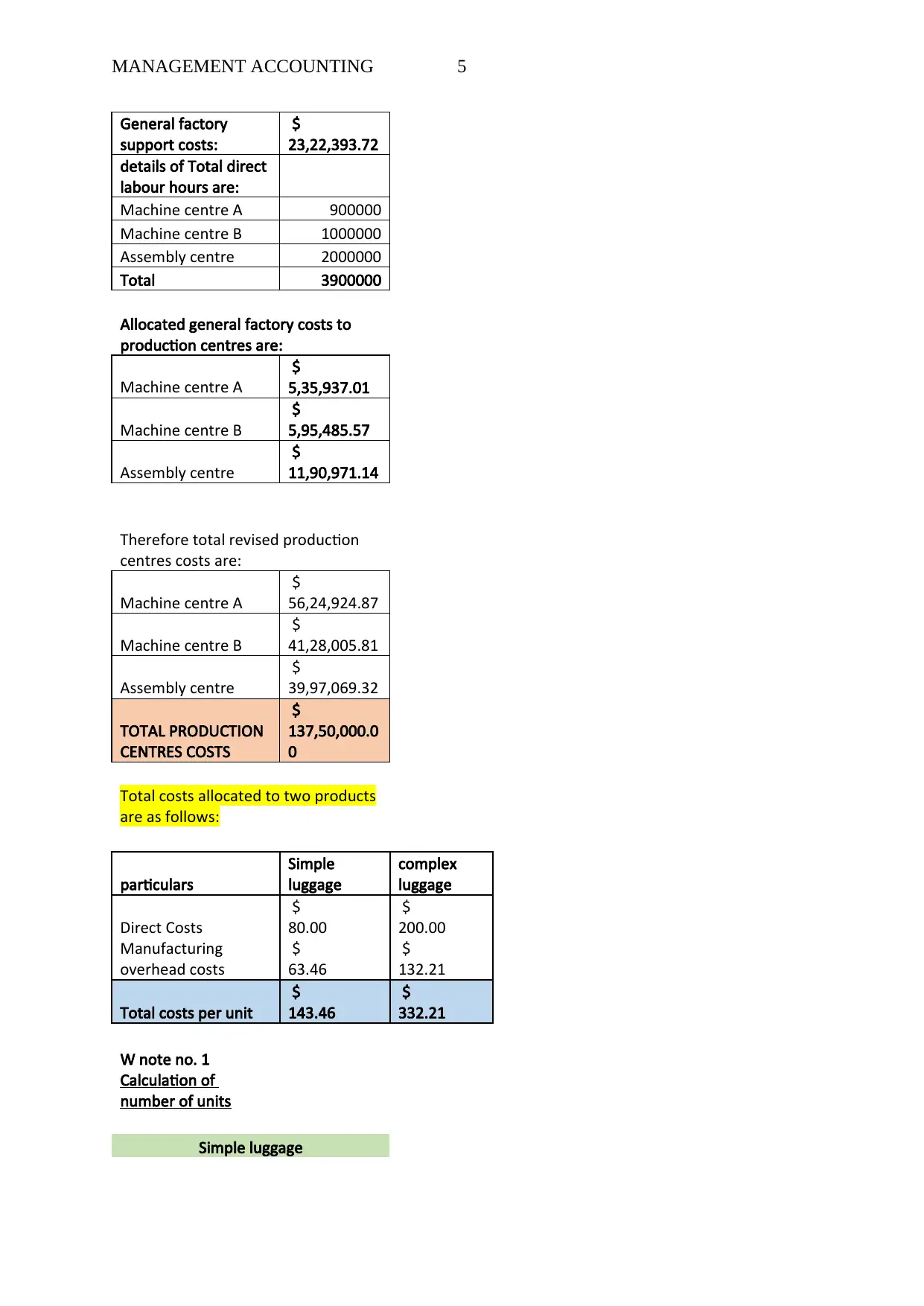
MANAGEMENT ACCOUNTING 5
General factory
support costs:
$
23,22,393.72
details of Total direct
labour hours are:
Machine centre A 900000
Machine centre B 1000000
Assembly centre 2000000
Total 3900000
Allocated general factory costs to
production centres are:
Machine centre A
$
5,35,937.01
Machine centre B
$
5,95,485.57
Assembly centre
$
11,90,971.14
Therefore total revised production
centres costs are:
Machine centre A
$
56,24,924.87
Machine centre B
$
41,28,005.81
Assembly centre
$
39,97,069.32
TOTAL PRODUCTION
CENTRES COSTS
$
137,50,000.0
0
Total costs allocated to two products
are as follows:
particulars
Simple
luggage
complex
luggage
Direct Costs
$
80.00
$
200.00
Manufacturing
overhead costs
$
63.46
$
132.21
Total costs per unit
$
143.46
$
332.21
W note no. 1
Calculation of
number of units
Simple luggage
General factory
support costs:
$
23,22,393.72
details of Total direct
labour hours are:
Machine centre A 900000
Machine centre B 1000000
Assembly centre 2000000
Total 3900000
Allocated general factory costs to
production centres are:
Machine centre A
$
5,35,937.01
Machine centre B
$
5,95,485.57
Assembly centre
$
11,90,971.14
Therefore total revised production
centres costs are:
Machine centre A
$
56,24,924.87
Machine centre B
$
41,28,005.81
Assembly centre
$
39,97,069.32
TOTAL PRODUCTION
CENTRES COSTS
$
137,50,000.0
0
Total costs allocated to two products
are as follows:
particulars
Simple
luggage
complex
luggage
Direct Costs
$
80.00
$
200.00
Manufacturing
overhead costs
$
63.46
$
132.21
Total costs per unit
$
143.46
$
332.21
W note no. 1
Calculation of
number of units
Simple luggage
⊘ This is a preview!⊘
Do you want full access?
Subscribe today to unlock all pages.

Trusted by 1+ million students worldwide
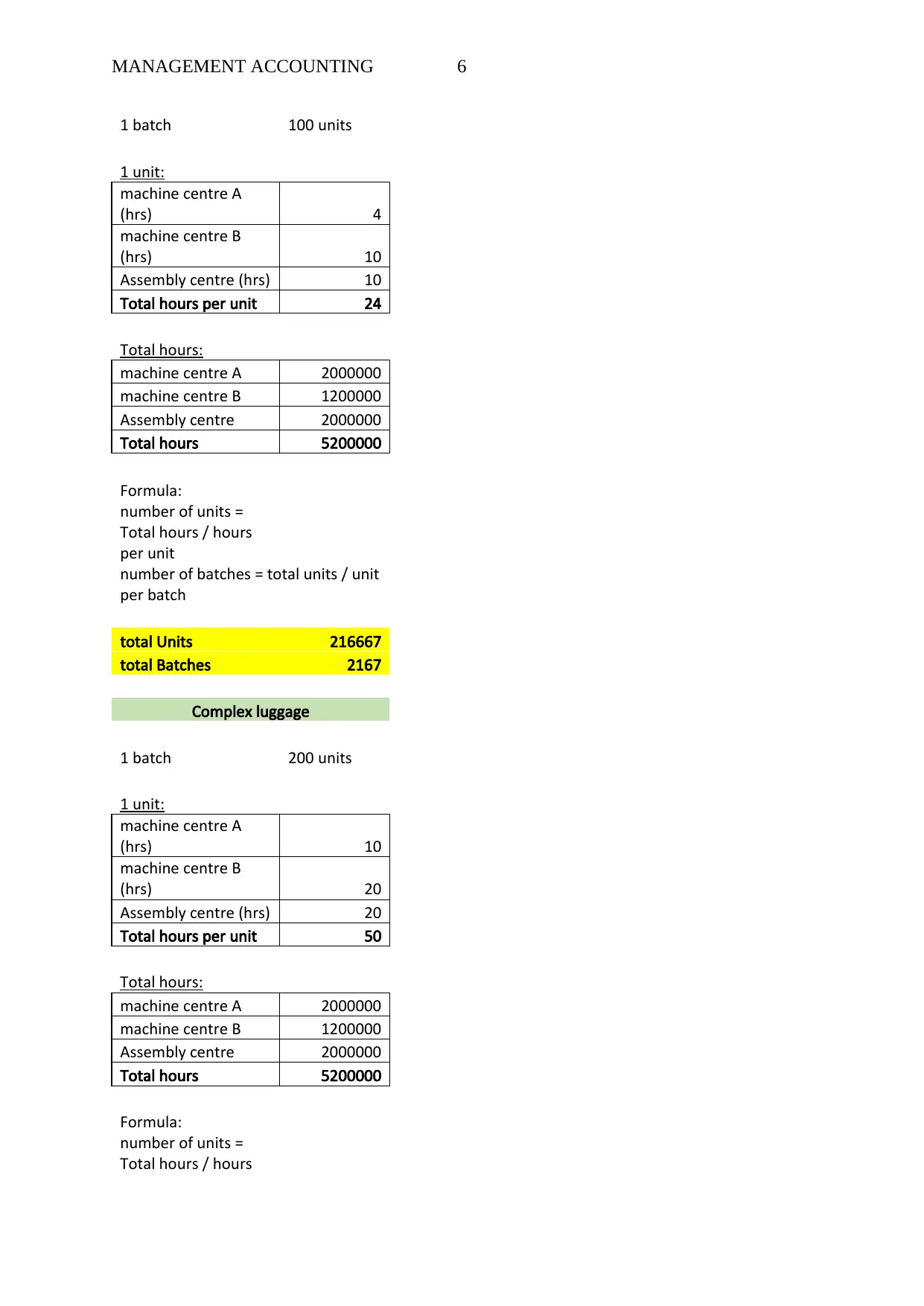
MANAGEMENT ACCOUNTING 6
1 batch 100 units
1 unit:
machine centre A
(hrs) 4
machine centre B
(hrs) 10
Assembly centre (hrs) 10
Total hours per unit 24
Total hours:
machine centre A 2000000
machine centre B 1200000
Assembly centre 2000000
Total hours 5200000
Formula:
number of units =
Total hours / hours
per unit
number of batches = total units / unit
per batch
total Units 216667
total Batches 2167
Complex luggage
1 batch 200 units
1 unit:
machine centre A
(hrs) 10
machine centre B
(hrs) 20
Assembly centre (hrs) 20
Total hours per unit 50
Total hours:
machine centre A 2000000
machine centre B 1200000
Assembly centre 2000000
Total hours 5200000
Formula:
number of units =
Total hours / hours
1 batch 100 units
1 unit:
machine centre A
(hrs) 4
machine centre B
(hrs) 10
Assembly centre (hrs) 10
Total hours per unit 24
Total hours:
machine centre A 2000000
machine centre B 1200000
Assembly centre 2000000
Total hours 5200000
Formula:
number of units =
Total hours / hours
per unit
number of batches = total units / unit
per batch
total Units 216667
total Batches 2167
Complex luggage
1 batch 200 units
1 unit:
machine centre A
(hrs) 10
machine centre B
(hrs) 20
Assembly centre (hrs) 20
Total hours per unit 50
Total hours:
machine centre A 2000000
machine centre B 1200000
Assembly centre 2000000
Total hours 5200000
Formula:
number of units =
Total hours / hours
Paraphrase This Document
Need a fresh take? Get an instant paraphrase of this document with our AI Paraphraser
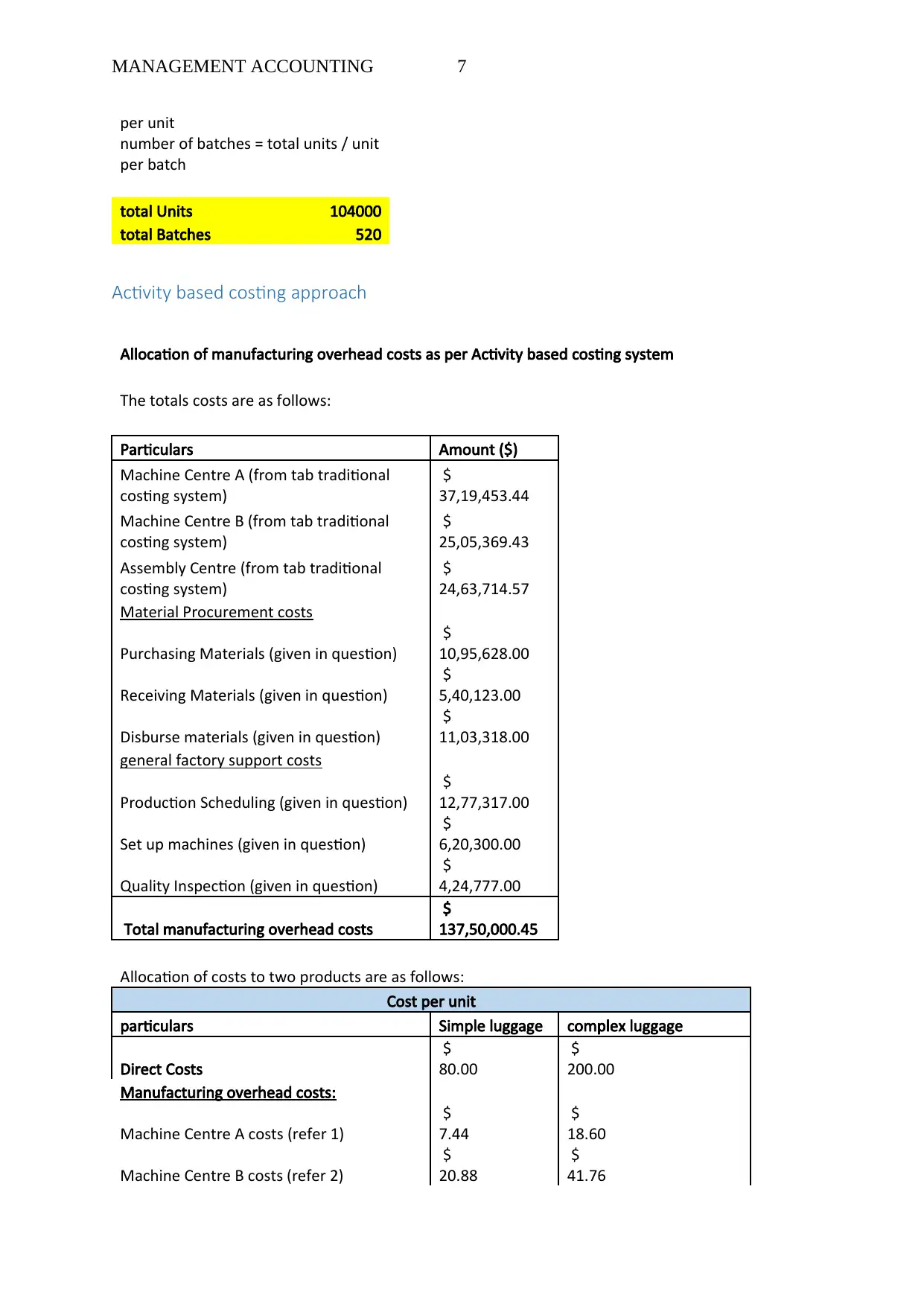
MANAGEMENT ACCOUNTING 7
per unit
number of batches = total units / unit
per batch
total Units 104000
total Batches 520
Activity based costing approach
Allocation of manufacturing overhead costs as per Activity based costing system
The totals costs are as follows:
Particulars Amount ($)
Machine Centre A (from tab traditional
costing system)
$
37,19,453.44
Machine Centre B (from tab traditional
costing system)
$
25,05,369.43
Assembly Centre (from tab traditional
costing system)
$
24,63,714.57
Material Procurement costs
Purchasing Materials (given in question)
$
10,95,628.00
Receiving Materials (given in question)
$
5,40,123.00
Disburse materials (given in question)
$
11,03,318.00
general factory support costs
Production Scheduling (given in question)
$
12,77,317.00
Set up machines (given in question)
$
6,20,300.00
Quality Inspection (given in question)
$
4,24,777.00
Total manufacturing overhead costs
$
137,50,000.45
Allocation of costs to two products are as follows:
Cost per unit
particulars Simple luggage complex luggage
Direct Costs
$
80.00
$
200.00
Manufacturing overhead costs:
Machine Centre A costs (refer 1)
$
7.44
$
18.60
Machine Centre B costs (refer 2)
$
20.88
$
41.76
per unit
number of batches = total units / unit
per batch
total Units 104000
total Batches 520
Activity based costing approach
Allocation of manufacturing overhead costs as per Activity based costing system
The totals costs are as follows:
Particulars Amount ($)
Machine Centre A (from tab traditional
costing system)
$
37,19,453.44
Machine Centre B (from tab traditional
costing system)
$
25,05,369.43
Assembly Centre (from tab traditional
costing system)
$
24,63,714.57
Material Procurement costs
Purchasing Materials (given in question)
$
10,95,628.00
Receiving Materials (given in question)
$
5,40,123.00
Disburse materials (given in question)
$
11,03,318.00
general factory support costs
Production Scheduling (given in question)
$
12,77,317.00
Set up machines (given in question)
$
6,20,300.00
Quality Inspection (given in question)
$
4,24,777.00
Total manufacturing overhead costs
$
137,50,000.45
Allocation of costs to two products are as follows:
Cost per unit
particulars Simple luggage complex luggage
Direct Costs
$
80.00
$
200.00
Manufacturing overhead costs:
Machine Centre A costs (refer 1)
$
7.44
$
18.60
Machine Centre B costs (refer 2)
$
20.88
$
41.76
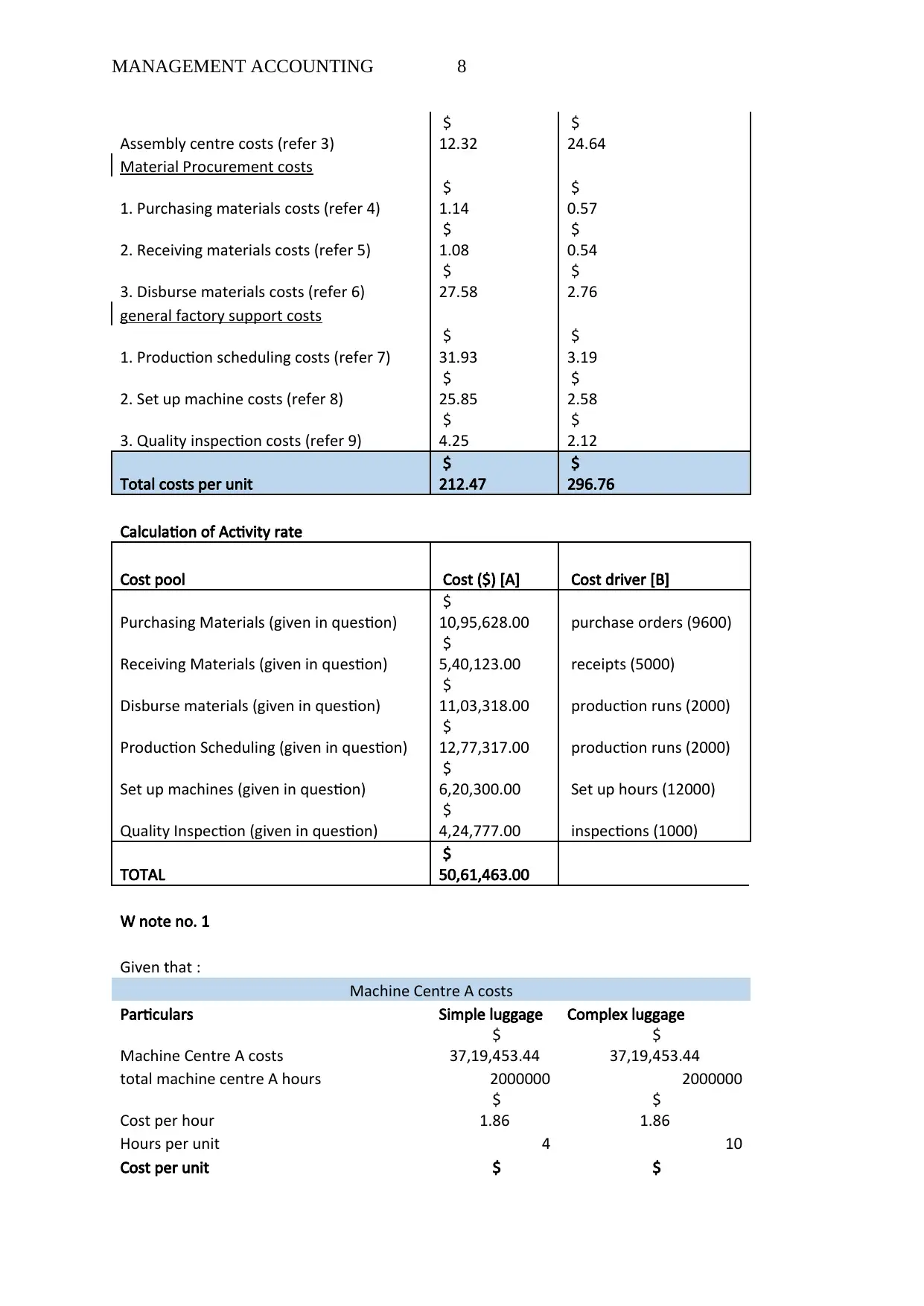
MANAGEMENT ACCOUNTING 8
Assembly centre costs (refer 3)
$
12.32
$
24.64
Material Procurement costs
1. Purchasing materials costs (refer 4)
$
1.14
$
0.57
2. Receiving materials costs (refer 5)
$
1.08
$
0.54
3. Disburse materials costs (refer 6)
$
27.58
$
2.76
general factory support costs
1. Production scheduling costs (refer 7)
$
31.93
$
3.19
2. Set up machine costs (refer 8)
$
25.85
$
2.58
3. Quality inspection costs (refer 9)
$
4.25
$
2.12
Total costs per unit
$
212.47
$
296.76
Calculation of Activity rate
Cost pool Cost ($) [A] Cost driver [B]
Purchasing Materials (given in question)
$
10,95,628.00 purchase orders (9600)
Receiving Materials (given in question)
$
5,40,123.00 receipts (5000)
Disburse materials (given in question)
$
11,03,318.00 production runs (2000)
Production Scheduling (given in question)
$
12,77,317.00 production runs (2000)
Set up machines (given in question)
$
6,20,300.00 Set up hours (12000)
Quality Inspection (given in question)
$
4,24,777.00 inspections (1000)
TOTAL
$
50,61,463.00
W note no. 1
Given that :
Machine Centre A costs
Particulars Simple luggage Complex luggage
Machine Centre A costs
$
37,19,453.44
$
37,19,453.44
total machine centre A hours 2000000 2000000
Cost per hour
$
1.86
$
1.86
Hours per unit 4 10
Cost per unit $ $
Assembly centre costs (refer 3)
$
12.32
$
24.64
Material Procurement costs
1. Purchasing materials costs (refer 4)
$
1.14
$
0.57
2. Receiving materials costs (refer 5)
$
1.08
$
0.54
3. Disburse materials costs (refer 6)
$
27.58
$
2.76
general factory support costs
1. Production scheduling costs (refer 7)
$
31.93
$
3.19
2. Set up machine costs (refer 8)
$
25.85
$
2.58
3. Quality inspection costs (refer 9)
$
4.25
$
2.12
Total costs per unit
$
212.47
$
296.76
Calculation of Activity rate
Cost pool Cost ($) [A] Cost driver [B]
Purchasing Materials (given in question)
$
10,95,628.00 purchase orders (9600)
Receiving Materials (given in question)
$
5,40,123.00 receipts (5000)
Disburse materials (given in question)
$
11,03,318.00 production runs (2000)
Production Scheduling (given in question)
$
12,77,317.00 production runs (2000)
Set up machines (given in question)
$
6,20,300.00 Set up hours (12000)
Quality Inspection (given in question)
$
4,24,777.00 inspections (1000)
TOTAL
$
50,61,463.00
W note no. 1
Given that :
Machine Centre A costs
Particulars Simple luggage Complex luggage
Machine Centre A costs
$
37,19,453.44
$
37,19,453.44
total machine centre A hours 2000000 2000000
Cost per hour
$
1.86
$
1.86
Hours per unit 4 10
Cost per unit $ $
⊘ This is a preview!⊘
Do you want full access?
Subscribe today to unlock all pages.

Trusted by 1+ million students worldwide

MANAGEMENT ACCOUNTING 9
7.44 18.60
W note no. 2
Given that :
Machine Centre B costs
Particulars Simple luggage Complex luggage
Machine Centre B costs
$
25,05,369.43
$
25,05,369.43
total machine centre B hours 1200000 1200000
Cost per hour
$
2.09
$
2.09
Hours per unit 10 20
Cost per unit
$
20.88
$
41.76
W note no. 3
Given that :
Assembly centre costs
Particulars Simple luggage Complex luggage
Assembly centre costs
$
24,63,714.57
$
24,63,714.57
total assembly hours 2000000 2000000
Cost per hour
$
1.23
$
1.23
Hours per unit 10 20
Cost per unit
$
12.32
$
24.64
W note no. 4
Given that :
Purchasing materials costs
Particulars Simple luggage Complex luggage
Purchasing materials costs
$
10,95,628.00
$
10,95,628.00
purchase orders 9600 9600
cost per order
$
114.13
$
114.13
units per batch 100 200
orders per batch 1 1
units per order 100 200
Cost per unit [cost per order/units per
order]
$
1.14
$
0.57
W note no. 5
7.44 18.60
W note no. 2
Given that :
Machine Centre B costs
Particulars Simple luggage Complex luggage
Machine Centre B costs
$
25,05,369.43
$
25,05,369.43
total machine centre B hours 1200000 1200000
Cost per hour
$
2.09
$
2.09
Hours per unit 10 20
Cost per unit
$
20.88
$
41.76
W note no. 3
Given that :
Assembly centre costs
Particulars Simple luggage Complex luggage
Assembly centre costs
$
24,63,714.57
$
24,63,714.57
total assembly hours 2000000 2000000
Cost per hour
$
1.23
$
1.23
Hours per unit 10 20
Cost per unit
$
12.32
$
24.64
W note no. 4
Given that :
Purchasing materials costs
Particulars Simple luggage Complex luggage
Purchasing materials costs
$
10,95,628.00
$
10,95,628.00
purchase orders 9600 9600
cost per order
$
114.13
$
114.13
units per batch 100 200
orders per batch 1 1
units per order 100 200
Cost per unit [cost per order/units per
order]
$
1.14
$
0.57
W note no. 5
Paraphrase This Document
Need a fresh take? Get an instant paraphrase of this document with our AI Paraphraser
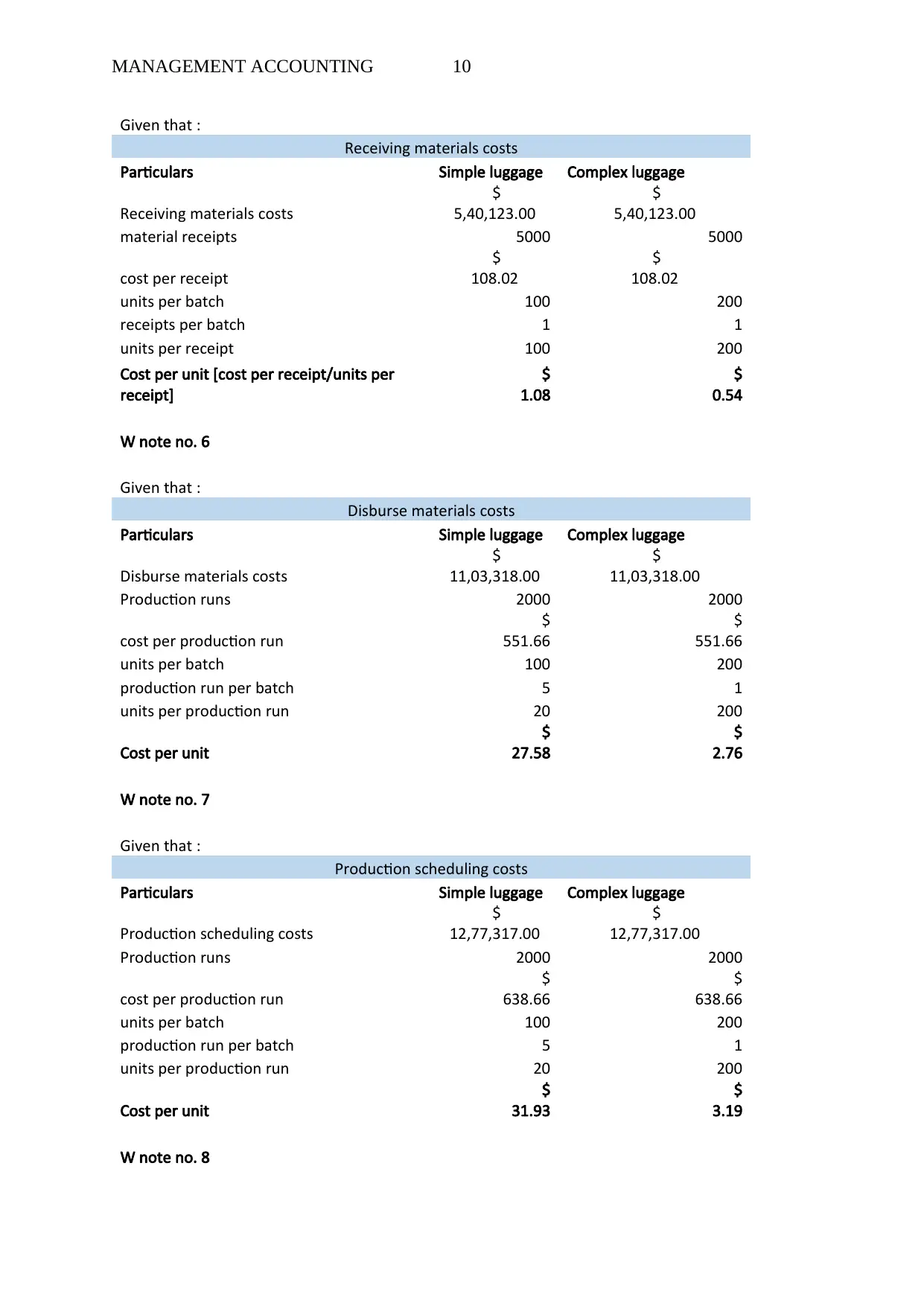
MANAGEMENT ACCOUNTING 10
Given that :
Receiving materials costs
Particulars Simple luggage Complex luggage
Receiving materials costs
$
5,40,123.00
$
5,40,123.00
material receipts 5000 5000
cost per receipt
$
108.02
$
108.02
units per batch 100 200
receipts per batch 1 1
units per receipt 100 200
Cost per unit [cost per receipt/units per
receipt]
$
1.08
$
0.54
W note no. 6
Given that :
Disburse materials costs
Particulars Simple luggage Complex luggage
Disburse materials costs
$
11,03,318.00
$
11,03,318.00
Production runs 2000 2000
cost per production run
$
551.66
$
551.66
units per batch 100 200
production run per batch 5 1
units per production run 20 200
Cost per unit
$
27.58
$
2.76
W note no. 7
Given that :
Production scheduling costs
Particulars Simple luggage Complex luggage
Production scheduling costs
$
12,77,317.00
$
12,77,317.00
Production runs 2000 2000
cost per production run
$
638.66
$
638.66
units per batch 100 200
production run per batch 5 1
units per production run 20 200
Cost per unit
$
31.93
$
3.19
W note no. 8
Given that :
Receiving materials costs
Particulars Simple luggage Complex luggage
Receiving materials costs
$
5,40,123.00
$
5,40,123.00
material receipts 5000 5000
cost per receipt
$
108.02
$
108.02
units per batch 100 200
receipts per batch 1 1
units per receipt 100 200
Cost per unit [cost per receipt/units per
receipt]
$
1.08
$
0.54
W note no. 6
Given that :
Disburse materials costs
Particulars Simple luggage Complex luggage
Disburse materials costs
$
11,03,318.00
$
11,03,318.00
Production runs 2000 2000
cost per production run
$
551.66
$
551.66
units per batch 100 200
production run per batch 5 1
units per production run 20 200
Cost per unit
$
27.58
$
2.76
W note no. 7
Given that :
Production scheduling costs
Particulars Simple luggage Complex luggage
Production scheduling costs
$
12,77,317.00
$
12,77,317.00
Production runs 2000 2000
cost per production run
$
638.66
$
638.66
units per batch 100 200
production run per batch 5 1
units per production run 20 200
Cost per unit
$
31.93
$
3.19
W note no. 8
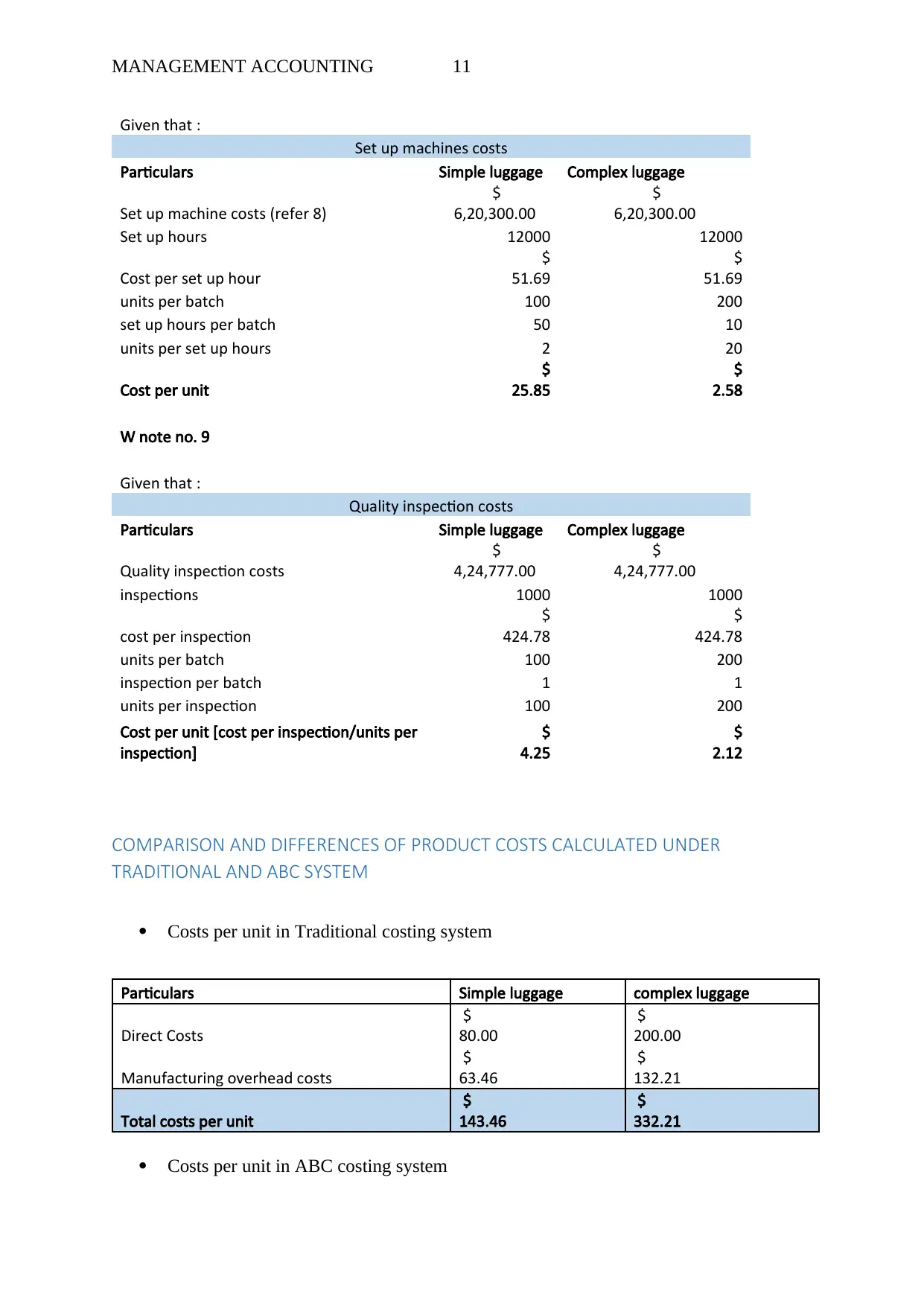
MANAGEMENT ACCOUNTING 11
Given that :
Set up machines costs
Particulars Simple luggage Complex luggage
Set up machine costs (refer 8)
$
6,20,300.00
$
6,20,300.00
Set up hours 12000 12000
Cost per set up hour
$
51.69
$
51.69
units per batch 100 200
set up hours per batch 50 10
units per set up hours 2 20
Cost per unit
$
25.85
$
2.58
W note no. 9
Given that :
Quality inspection costs
Particulars Simple luggage Complex luggage
Quality inspection costs
$
4,24,777.00
$
4,24,777.00
inspections 1000 1000
cost per inspection
$
424.78
$
424.78
units per batch 100 200
inspection per batch 1 1
units per inspection 100 200
Cost per unit [cost per inspection/units per
inspection]
$
4.25
$
2.12
COMPARISON AND DIFFERENCES OF PRODUCT COSTS CALCULATED UNDER
TRADITIONAL AND ABC SYSTEM
Costs per unit in Traditional costing system
Particulars Simple luggage complex luggage
Direct Costs
$
80.00
$
200.00
Manufacturing overhead costs
$
63.46
$
132.21
Total costs per unit
$
143.46
$
332.21
Costs per unit in ABC costing system
Given that :
Set up machines costs
Particulars Simple luggage Complex luggage
Set up machine costs (refer 8)
$
6,20,300.00
$
6,20,300.00
Set up hours 12000 12000
Cost per set up hour
$
51.69
$
51.69
units per batch 100 200
set up hours per batch 50 10
units per set up hours 2 20
Cost per unit
$
25.85
$
2.58
W note no. 9
Given that :
Quality inspection costs
Particulars Simple luggage Complex luggage
Quality inspection costs
$
4,24,777.00
$
4,24,777.00
inspections 1000 1000
cost per inspection
$
424.78
$
424.78
units per batch 100 200
inspection per batch 1 1
units per inspection 100 200
Cost per unit [cost per inspection/units per
inspection]
$
4.25
$
2.12
COMPARISON AND DIFFERENCES OF PRODUCT COSTS CALCULATED UNDER
TRADITIONAL AND ABC SYSTEM
Costs per unit in Traditional costing system
Particulars Simple luggage complex luggage
Direct Costs
$
80.00
$
200.00
Manufacturing overhead costs
$
63.46
$
132.21
Total costs per unit
$
143.46
$
332.21
Costs per unit in ABC costing system
⊘ This is a preview!⊘
Do you want full access?
Subscribe today to unlock all pages.

Trusted by 1+ million students worldwide
1 out of 15
Related Documents
Your All-in-One AI-Powered Toolkit for Academic Success.
+13062052269
info@desklib.com
Available 24*7 on WhatsApp / Email
![[object Object]](/_next/static/media/star-bottom.7253800d.svg)
Unlock your academic potential
Copyright © 2020–2026 A2Z Services. All Rights Reserved. Developed and managed by ZUCOL.





